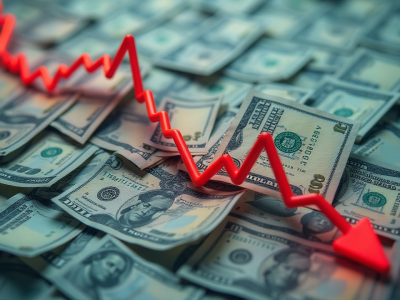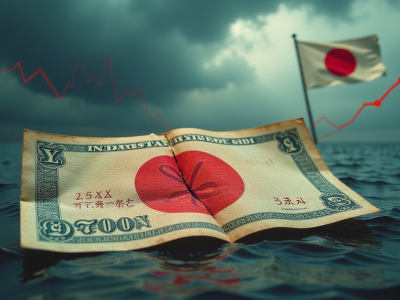
With the US presidential election approaching, market analysts are closely eyeing the potential impact of a Trump win on the euro-dollar exchange rate.
The euro has already fallen over 2% in the past month amid rising speculation of a Trump victory, as his policy proposals hint at a return to US protectionism that could shift global economic dynamics.
Economists largely agree that another Trump administration could weaken the euro, potentially pushing it to parity—or even below—against the dollar.
Why a Trump victory could impact the euro?
One of the main drivers of potential euro weakness is Trump’s tariff agenda.
The former president has proposed tariffs of 60% on Chinese goods and 10% on other imports, aimed at reshoring jobs to the United States.
Economists caution that such tariffs could heighten inflation domestically, as companies pass higher import costs onto consumers.
This inflationary pressure might prompt the Federal Reserve to act by raising interest rates, a move that would attract investors to higher-yielding US assets and strengthen the dollar.
European exporters could also suffer under Trump’s trade policies, particularly those in Germany, Italy, and France, who count on the US as a key market.
In response, the European Central Bank (ECB) may be forced to ease its monetary policy to offset the economic drag, potentially leading to a looser stance on interest rates.
A widening interest rate gap between the Federal Reserve and ECB would likely support the dollar and further undermine the euro.
Beyond tariffs, Trump’s stance on immigration is another factor likely to influence currency markets.
Restricting immigration could tighten the US labor market, driving wages higher as companies compete for workers.
According to some analysts, this upward wage pressure could also fuel inflation, making a more hawkish stance by the Federal Reserve probable and giving additional support to the dollar.
What do analysts say?
Several currency experts have shared insights on what a Trump victory could mean for the euro-dollar rate.
Luca Santos, a foreign exchange analyst at ACY Securities, stated in a Euronews report,
A potential Trump victory could bring policy shifts aimed at boosting US economic growth through domestic spending and a more protectionist trade stance. Such a scenario often leads to a stronger dollar, as investors bet on a favourable economic climate for US assets.
Georgette Boele, Senior FX & Precious Metals Strategist at ABN Amro, emphasized the dollar’s resilience, observing that “markets have priced in fewer rate cuts for the Fed this year following strong US data, but more for the ECB.”
Boele noted that polling shifts have fuelled recent volatility in the dollar, with Trump’s rising odds affecting short-term currency moves.
Other analysts are equally wary of the euro’s future in a post-election Trump scenario.
Alejandro Cuadrado and Roberto Cobo, strategists at BBVA, predict that a Republican sweep could see the euro drop below $1.08.
Michael Cahill of Goldman Sachs provided one of the more bearish views, suggesting that “diverging monetary policy implications for the US and Europe could weaken the euro by about 3%.”
If Trump’s tariffs and proposed domestic tax cuts are implemented, Cahill speculates the euro could fall an additional 10%, potentially bringing it below parity with the dollar.
What could be different this time?
The effects of Trump’s first term on currency markets provide some context but not necessarily a direct forecast for 2024.
When Trump first took office in 2016, the dollar surged, and the euro declined from $1.10 in October 2016 to $1.034 by early 2017.
As Stefan Gerlach, Chief Economist at EFG Bank AG, explained, “The US election prompted a significant increase in US interest rates as markets anticipated Trump’s economic policies would stimulate growth and inflation.”
This anticipation led to a widening interest rate gap between US and German bonds, which added to downward pressure on the euro.
However, by mid-2017, the euro began to strengthen as Trump’s legislative agenda stalled and European growth improved.
Political stability in the eurozone, particularly pro-EU election results in France and the Netherlands, also boosted the currency’s recovery.
Ultimately, Trump’s first term saw the euro appreciate from $1.10 to $1.18 against the dollar by November 2020, when the Covid-19 pandemic led to looser Fed policies that weakened the dollar further.
The landscape is different in 2024. With inflation a more persistent challenge, any added pressure from Trump’s tariffs or immigration policies could spur the Fed to tighten monetary policy sooner rather than later.
The ECB, on the other hand, remains focused on an economic recovery that is more vulnerable to global trade tensions.
If Trump’s policies disproportionately affect European exports, the ECB may have no choice but to pursue easing measures, widening the interest rate differential and adding to downward pressure on the euro.
Investors on high alert
For investors monitoring the euro-dollar exchange rate, the prospect of a Trump victory brings a series of potential changes to consider.
A combination of renewed US protectionism, inflation risks, and diverging monetary policies could all play critical roles in driving the euro closer to parity with the dollar.
While economists caution that no scenario is guaranteed, a Trump-led economic environment could trigger key shifts in both the US and European economies.
As Gerlach puts it, “The effects of interest rate differentials can be profound and, combined with external economic policies, may drive the euro to historically low levels.”
Investors would do well to brace for increased volatility as Election Day approaches.
The post US election 2024: could a Trump presidency push the euro to dollar parity? appeared first on Invezz












